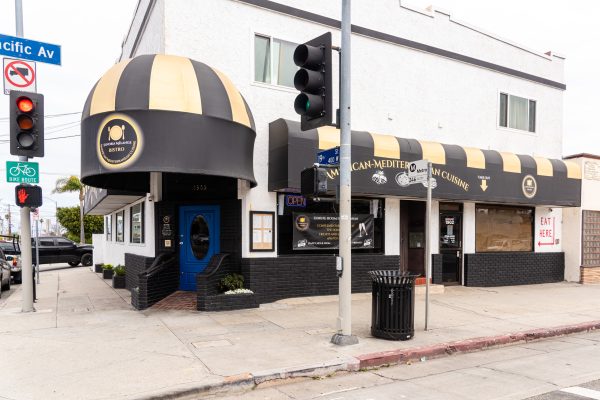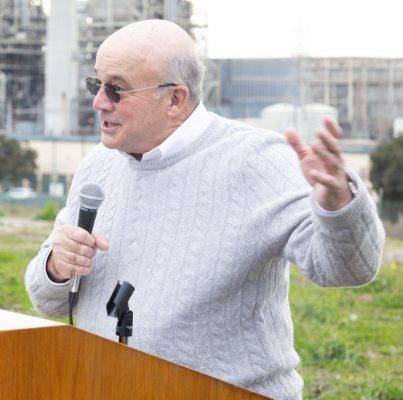
Amid a statewide housing crisis, Hermosa confronts accessory dwelling units, density and identity
Spray paint scrawlings all but cover the chalk-colored walls. A drum kit, shoes, and assorted flotsam crowd the floor, while a noose hangs from the ceiling. Amplifiers serve as impromptu furniture. A man with a mohawk sips Colt 45 and sits in a stuffed armchair that looks as though it has been attacked by a hyena. This, titles tell the viewer, is downstairs at “The Church,” the Hermosa Beach home of Black Flag.
“It used to be a Baptist Church, and now they just rent out all the rooms in it. There are some other bands in here. We practice here, and [singer] Ron [Reyes] lives here, and [drummer] Robo lives here,” says band founder Greg Ginn. Ginn and the other members of Black Flag are downstairs in the Church talking to filmmaker Penelope Spheeris for her 1981 Southern California punk documentary, “The Decline of Western Civilization: Part I.”
“What’s the most people that ever lived here?” Spheeris asks.
“A bunch of hippies run it,” Ginn responds, not really answering the question.
Spheeris goes with it. “What about the hippies, do you get along with them?”
“They’re okay because they just get loaded,” Ginn says through a goofy grin.
Spheeris asks Reyes to show her where he lives.
“You mean, specifically where I sleep? Okay, well this room is where I live. This is a two-bedroom apartment,” Reyes says. He wades through the detritus on the floor and reaches for a door that blends into the wall because it too is covered in graffiti. “It’s not exactly a penthouse suite.”
The room looks like the advance position of a budget-minded coal extractor, down to the industrial lantern hanging from the sloped ceiling. A cot takes up most of the floor, while more graffiti and a stripe of leopard print cover the walls. “This is my … this is where all the action goes on,” Reyes says. Undergarments belonging to women who have somehow been convinced to spend the night in the Church are scattered about. He picks one up and says, with jesting menace, “Another one of my victims.”
Reyes then directs Spheeris to Robo’s “room.” He opens a tiny door closer to the ceiling, above a graffito reading “Remember the Altamont,” and peels back a square of flannel to reveal a space the size and shape of a coffin.
“How much does it cost?” Spheeris asks.
“Uh, $16 a month,” Reyes says in between sips of beer.
“How much do you make a month, as a performer?” Spheeris said.
“Pretty much nothing,” Reyes replies. He is incapable of renting a traditional house, he said, because of outstanding debts to the gas, electric and phone companies. “I can’t rent a house under my name, so I might as well live in an [expletive] closet for $16 a month.”
Today, the spot downtown in Hermosa that once contained the Church is home to Abigaile and the Alta House, establishments where one would strain to cover a stiff drink with tax and tip for $16. The Church was a cultural petri dish that shaped the South Bay punk scene, and it will be prominently memorialized later this year when the Hermosa Beach Murals Project debuts its eighth entry, devoted to punk and skateboarding. (A halfpipe would later take root on the grounds.) But the Church also symbolizes another, only slightly less romanticized part of Hermosa and the South Bay’s history: cheap housing.
Reyes, Robo, and others forged a sub-bohemian existence in a town that today boasts some of the highest home prices in the country. They were able to do so not only because land values in the South Bay had yet to explode, but because of an abundance of older apartment buildings, converted garages and backyard units. (Even for Hermosa in the Carter Administration, $16 a month was a steal.) Over the years, these options have steadily disappeared.
Thanks to recent laws coming down from Sacramento, however, they may be making a comeback. In 2016 and 2017, the California legislature passed a series of bills to encourage accessory dwelling units (ADUs). Also known as “granny flats” or “in-law units,” ADUs are small units built either within an existing single-family home or elsewhere on the lot. For years, they have been heavily restricted in Hermosa and other cities throughout the state. But as California plunges deeper into a housing crisis, legislators searching for housing alternatives have tapped ADUs as one possible solution.
Although the specter of dirty and dangerous bootlegs is part of what made ADUs increasingly rare in California in recent decades, those built in Hermosa are unlikely to be as dingy, or as affordable, as the spaces at the Church. But the ADU laws epitomize the way the housing crisis has pushed Sacramento to deploy a heavier hand in what were once local land use decisions, a legislative push that is likely to continue in future sessions. It is creating new fights on some of the most contentious issues cities deal with, like traffic and parking. And most of all, ADUs and the state’s housing crisis are forcing cities like Hermosa to confront density, and the ways that it can define a place’s identity. As one Torrance City Council member asked during a debate earlier this year, with an answer clearly in mind, should a city be able to hang out a “no vacancy” sign?
“I don’t mean to be heartless in the matter, but we’re already pretty well crammed in here,” said resident and Hermosa Public Works Commissioner David Grethen.

On the horizon
Around the same time that Black Flag was holding court with Spheeris — filming for the first “Decline” took place between December 1979 and May 1980 — the city was putting the finishing touches on its General Plan, a master land use document that the state requires cities to update every few generations. Resident George Schmeltzer, who was on the Hermosa City Council in those years, said that he and other residents had been eyeing the city’s housing plan for more than a decade. Starting in the late 1960s, they organized and began getting involved in politics.
“We were young, we were involved in the anti-war movement. ‘The man’ was bad. But once we realized that there were people in the city trying to do what they thought was right, and they weren’t just a bunch of fascist warmongers, we started looking at how you could make an impact, how you could change that,” Schmeltzer said in an interview. “We looked at the General Plan and zoning. We got people on the Planning Commission and the Council.”
This group of residents examined the city’s existing General Plan and zoning map and saw a ticking time bomb. Increased density, they feared, would snarl traffic, make parking even harder to find, and generally reduce quality of life. Presuming that lots would be filled in what zoning terminology deems the “highest and best use,” Schmeltzer and his cohorts used the average family size to estimate that Hermosa’s population, left unchecked, would reach 30,000 people within a few decades.
And, in what he described as a highly contentious process, they worked to downzone the city. Among other reforms, they got the minimum lot size changed from 3500 square feet to 4000 square feet, which reduced the number of units that could be added to the city’s housing stock.
“It was very controversial, very difficult to do. You’re hurting people — not on purpose, but people are being affected. They could have built two units, now they can only build one. It’s unlike anything else you can do as government. It’s a hidden tax,” Schmeltzer said. “All of a sudden, there’s a bunch of people that can’t develop their properties.”
Although the City Council unanimously approved its updates to the General Plan last August, known as PLAN Hermosa, the updates to the municipal code it requires are expected to take up to two years to complete, meaning that the 1980 General Plan is still largely in force. And it has worked as intended. The Census Bureau’s estimate for Hermosa’s 2017 population was 19,078 people, a number that has remained stable for years.
These reforms by Schmeltzer’s generation of residents helped define the look and feel of Hermosa today in ways that are so fundamental they are difficult to detect or understand. Indeed, when Hermosa was in the process of updating its General Plan last year, zealous advocates of property rights were often the greatest opponents of increasing density.
This is in part due to an unforeseen consequence of the zoning changes: a massive increase in the price of real estate. As land values climbed, many property owners became less concerned about the loss of potential rental income from second units than the diminished value of a house in a neighborhood that struggles with parking. Although the rise in home values cannot be solely explained by the supply restrictions put in place at that time, Schmeltzer admitted that the reforms may have had “a negative impact on the city in terms of who could afford to live here.” Discussion of this issue foreshadowed the scrambled political alliances that local housing issues could produce.
“We had one person on the council that I remember, Jack Wood, very conservative guy. And he used to point out that, you know, we were driving out the artsy community. We all recognized that was possible, that you would change the demographics of the community,” Schmeltzer said. “But then again, you might change your mind after you talk to the guy who lived next door to an absentee owner, multiple cars, no garage.”
For longtime owners, rising home prices are perhaps the best result of the restrictions on supply. And ironically, some opponents of the new ADU laws are making the exact same argument that those opposed to the lot restrictions made decades ago: that changing buildout potential will negatively impact property values. At a Planning Commission hearing on the ADU laws, Schmeltzer’s former council colleague Jim Rosenberger said that the new rules coming down from Sacramento would undo much of the work done at that time.
“And property values certainly haven’t gone down since then,” Rosenberger added.
Supply and demand
Property values are typically the first piece of evidence used to demonstrate that California is in the midst of a housing crisis. According to the California Association of Realtors, which has supported several of the recent state legislative efforts on accessory dwelling units, home sales data from June revealed a statewide median home price of $602,760. This is an all-time high for the state and an 8.5 percent increase from a year ago. In a report released earlier this year, when the median price was tens of thousands of dollars lower, the association found that only 31 percent of households in the state could afford the median home.
Things are just as bad for renters. According to the federal Department of Housing and Urban Development, a family is considered “cost-burdened” if it pays more than 30 percent of its income in rent. More than half of California renters pay more than 30 percent of their income each month; about a third spend more than half.
The main factor driving the rising prices is that supply — the construction of new homes — has not kept up with demand.
“Over last 20 years, the state has fallen behind by 2 million units. There are different ways of measuring this, but basically, there should be 2 million more housing units in California than there is today. It’s driving up the prices, and it’s driving up rent for the same reasons,” said David Kissinger, government affairs director for the South Bay Association of Realtors.

Kissinger notes that despite the proliferation of stories about people leaving the state — often due to high housing costs — and a reputation for being a tough place to do business, the housing market in California has shown no sign of loosening. For the South Bay, which the association defines as stretching from El Segundo to San Pedro and east to Carson, inventory for July 2018 is down 18 percent compared to July 2016. And what is available is going quickly. According to the housing supply figures, if no new homes were to come on the market, the South Bay’s existing inventory would be consumed in about seven weeks. A healthy market figure, Kissinger said, is between five and seven months. “People may be leaving, but enough people are coming that there is still a demand,” he said.
According to a widely cited analysis from the McKinsey Global Institute, California will need to build 3.5 million housing units by 2025 in order to satisfy pent-up demand and keep up with population growth. This averages out to more than 437,000 units per year; in 2016, developers built only 90,000.
In a state as large and diverse as California, the housing crisis has produced a largely unified response, at least from people who are employed by the state. Legislators have overwhelmingly backed housing legislation, including bills like Assembly Bill 494 and Senate Bill 229, on accessory dwelling units. In 2017, AB 494 passed the Assembly 76-1, and the state Senate 40-0. SB 229, which also passed last year, cleared the Senate 40-0 and sailed through the Assembly 76-2. Both candidates for governor, Republican John Cox, and Democrat Gavin Newsom, have also made aggressive expansion of homebuilding part of their platforms.
Mark Vallianatos, communications director of Abundant Housing LA, a nonprofit organization that advocates for expanded housing availability in Southern California, said that the pressure from Sacramento is rooted in the obstinacy of local governments over the past decades. Their action, or inaction, is responsible for driving up the price of housing to the point that it is unaffordable for most residents, Vallianatos said. The statewide laws may be blunt instruments, but obstruction at the local level has essentially forced the state’s hand.
“Because cities have been essentially banning these structures for so long, it requires strong state action. If most cities had a reasonable way to add ADUs, then you wouldn’t need the state to come in. But the stark reality is that they haven’t,” Vallianatos said.
Jason Rhine, assistant legislative director for the League of California Cities, admitted that the lopsided votes do reflect the depth of the state’s housing crisis. But for the League, which has sought amendments to some of the recent ADU bills in its work advocating for local governments, the laws are also a kind of buck-passing.
“The votes are one-sided, and it’s really not a partisan issue either. I think the legislature is acknowledging affordability in general, and the lack of supply,” Rhine said. “But there are significant policy issues out there at the state level, and those are hard issues. It’s easier to focus on, what’s local government doing? What are the NIMBYs crying about? That’s an easy vote. It’s much more difficult to tackle issues with [the California Environmental Quality Act], building costs, and Prop. 13.”
Kissinger, of the Realtors’ association, acknowledges that cities are being put in a tough spot.
“Looking at the South Bay, there is nowhere to build more stuff, nowhere to put new homes, if you’re talking about traditional, single-family homes. South Bay cities have a choice. It’s not my choice to make. It’s up to councils, to mayors, to voters. And I don’t want to oversimplify it, but the choice is new units, which may include increased density: more housing, more cars, more traffic. Or do you leave it alone, and say ‘No more density, this is what our residents like.’ You can do that, but then you still have a supply problem. Here’s my favorite question: Where are your kids going to live? I have two daughters at home, and I do not have a lot of confidence that, when they are old enough, they will be able to afford homes here,” Kissinger said.
The law
Until recently, Hermosa’s most relevant law on the subject of accessory dwelling units came from an ordinance passed in 1992. Under a state law in force at the time, cities could limit ADUs by making findings about negative impacts the added units might create. Hermosa, for its part, cited negative impacts on “traffic, density, the school system, infrastructure, loss of open space, increased impervious surfaces,” and “increase of solid waste generation.” The only places where second-units would be permitted would be on lots of at least 8,000 square feet, and there had to be at least two parking spaces provided for every unit.
The recent ADU bills repealed the state law allowing cities to enact strict limits on ADUs, and put in place the same default regulations for every city in California. So, until Hermosa formally approves the code amendments on accessory dwelling units, which it is expected to do at the upcoming Aug. 28 council meeting, the law governing the units is the law established by the state of California. The prospect of a deluge of units, which would have to be processed without the input of commissioners of elected officials, is part of what prompted officials’ urgency. When the city council gave initial approval to the ordinance last month, city staff said that there were five pending ADU applications. (One person who has filed an application for an ADU declined an interview request for this story, citing concerns that it could negatively impact the application with the city.)
Under the rules the Council agreed on in July, ADUs will be allowed only on residentially zoned lots of 4,000 square feet or greater — the minimum lot size for a new home, thanks to Schmeltzer and his colleagues — containing a single family home. Planning staff says that there are just under 1,600 parcels meeting this description in the city.
The attitude leading up to this agreement has been one of reluctant compliance; Planning Commission Chairman Rob Saemann described the process of crafting the rules as working with the state “holding a gun to our head.” The state laws do not permit cities to impose parking requirements for ADUs within a half mile of “public transit.” When it appeared before the Planning Commission, the first draft ordinances interpreted that provision to mean those parking requirements could not be imposed anywhere, due to Hermosa’s small size and the four bus routes that flow through it. When the ordinance returned, staff offered a new interpretation of “public transit” that allowed a parking requirement of one space per bedroom to be imposed on every potential ADU in the city.
In an interview, an official with the state Housing and Community Development Department cast doubt on this interpretation, and Councilmember Justin Massey cited his concerns about it while voting against the city’s ordinance last month. The purpose of the ADU laws, the state housing official said, was to make them easier to build, and requiring parking can significantly increase their expense.
But parking shortages are not equally acute throughout the state, and some worry the Legislature’s broad-brush approach could lead to a host of other issues.
“Under existing law, someone could theoretically put an ADU in a high fire-severity area. We want cities to be able to put conditions on certain areas like that. Do we really want to double down on density in an area where maybe there shouldn’t be a home in the first place?” Rhine said.
When the Planning Commission was considering the ordinance, Commissioner Pete Hoffman, who is also a professor of urban planning at Loyola Marymount University, said the failure to differentiate among cities with wildly different levels of density was the biggest problem with the state’s push for ADUs. Hermosa is the ninth densest city in Los Angeles County and, Hoffman argued, was already providing more than its share of needed housing units.
“It may make sense if I’m in Moreno Valley. It doesn’t make sense in a city that has 20,000 residents in a mile and a half, basically. We’re not the ones that are going to solve the state’s housing problem,” Hoffman said.
The population of the region, though, is going to continue to grow. According to forecasts from the Southern California Association of Governments — which covers Los Angeles, Orange, Riverside, Ventura, San Bernardino and Imperial Counties — the area will add more than 3.3 million people by 2040. And although this is not explicit in the legislative history of the ADU laws that have passed, the state may well have an interest in ensuring that more of them live in places like Hermosa.
To combat climate change, California has imposed the country’s toughest greenhouse gas laws, including a mandate to reduce emission levels 40 percent below 1990 levels by 2030. The state has already made considerable progress in reducing emissions from power plants and in minimizing the energy consumed by buildings. But transportation emissions, in California as in the rest of the country, remain stubbornly high. Government bodies and planning organizations have issued projections indicating that it will be challenging for the state to meet the goals of SB 32 without limiting urban sprawl and the driving patterns that go along with it.
According to the 2017 Climate Change Scoping Plan Update, from the California Air Resources Board, to meet its 2030 goal the state should aim to quadruple the number of trips taken by foot, as compared to levels measured between 2010 and 2012; trips by bicycle should increase by a factor of nine. In Hermosa, the density that already exists means that added residents would be better able to rely on walking or biking for many basic needs. And its proximity to ultra-dense job centers like downtown Los Angeles means that shorter commutes and use of public transit are far easier than in far-flung exurbs — like those in Moreno Valley.
Propositions
Hermosa is not alone in its foot-dragging approach to the expansion of ADUs. The decision to change the language of the “public transit” parking requirement came from a similar ordinance adopted by the city of Carlsbad. And when El Segundo adopted its own ADU rules last year, the city chose to prohibit garage conversions, which has led to an ongoing feud with state housing regulators.
In general, it has been smaller cities that have been most apt to tweak the state rules to fit their needs, while larger cities have been more inclined to simply take on the default rules. Vallianatos, of Abundant LA, said that this is rooted in the endurance of an exclusively single-family home ideal that emerged after World War II but is, for much of the region, actually ahistorical.
“The strength of many of the neighborhoods that people love most in Southern California is diversity of housing: a mix of duplexes, bungalow courts, and single-family homes. [The new ADU laws] just legalize that kind of low-rise diversity. It’s the best of urbanism,” he said.
Vallianatos said that ADUs provided a “moderate approach” to addressing the housing crisis, and pointed out that other proposed laws have been far more aggressive, like SB 827, a bill that would have significantly restricted the zoning power of cities and could have led to the proliferation of mid-rise housing, with potentially far greater impacts on density. Although SB 827 died in committee this spring, it came close enough to scare people in local government throughout the state.
The Legislature shows no sign of slowing down on housing. Several more ADU bills are currently winding their way through Sacramento, including one that would give the Attorney General’s office the authority to investigate a city’s lack of compliance, and another that prevent cities from imposing “capacity charges,” fees associated with the additional costs ADUs impose.
“It’s absolutely a concern. As more people move into communities, and were unable to charge developers or whoever is bringing them into the community, someone is going to have to provide those services, or there’s going to be a lack of services in the community. How do we have libraries, open space, parks? Or how do we have the funds to maintain those things? More people demand more services,” Rhine said.
But for local ADU advocates, these arguments ignore the benefits that the added units — and the people who could fill them — provide to a community. Resident Betsy Ryan has spoken at council and commission meetings in Hermosa with concerns about the city’s proposed limitations. Ryan owns an apartment building near downtown and would not be eligible to put an ADU on her property, but said allowing people to build “tiny cottages” on single-family lots would create places for elderly people to move into when they retire, or to house a caregiver. And that, she said, is just the beginning.
“The people who would be staying here are exactly the people we want in our community. They need a chance to be able to move in to one of these places. They might do really important jobs that don’t pay a lot but are critically important. People with these jobs shouldn’t have to commute long distances, it’s bad for the environment. Or they might be artists who don’t have a lot of money. And then there are people who grew up here. It really bothers me that it’s becoming so hard for people who grew up here to stay,” Ryan said.
Like Vallianatos, Ryan views ADUs as a way for the state to release a bit of the steam building up beneath the state’s housing crisis. She has seen how tough the competition is for available rental units in Hermosa and warned that ongoing inaction could broaden popular support for rent control, which she said disincentivizes landlords from performing maintenance on buildings. And indeed, an initiative that would largely repeal the state’s ban on rent control in structures built after 1995 will face voters this November, along with a bond to fund the construction of affordable housing. (The state Legislative Analyst has said that evidence of the effect of rent control policies on housing availability is mixed.)
The question of whether rent at ADUs in places like Hermosa will be at all “affordable” has fueled skepticism about their expansion, but various groups in government and the private sector are exploring options. LA-Más, a nonprofit focused on affordable housing design and policy, recently rolled out a pilot project that helps Los Angeles homeowners build an ADU on their property. The organization facilitates the permitting process and helps fund construction in return for a pledge by the homeowner to rent out the home at affordable prices for five years. The program has the benefit of avoiding a covenant on the property that accompanies many affordable housing projects built with federal funding, some lasting as long as 55 years.
Helen Leung, the co-executive director of LA-Más, said that the question was “How can the government not just get out of the way so more ADUs can be built, but get in the way to make sure ADUs are affordable?” Her organization conducted an extensive survey before it launched the program, and found that some obstacles associated with building an ADU, like hiring an architect and obtaining permits, were difficult to surmount even for middle-income residents. Streamlining building and permitting requirements, she said, could make all housing, including ADUs, easier to build. Since the new state laws passed, about 2,000 units have been permitted by the city of Los Angeles, but “my assumption is that the majority of these are developer-done or on lots owned by high-income residents. The average homeowner will not have the wherewithal to go through all that,” Leung said.
These, however, represent only a fraction of the true number of ADUs in the city, Leung said. Most estimates place the number of ADUs in Los Angeles at about 50,000, almost all of them unpermitted. Legitimizing ADUs could provide the chance to prevent more building code violations, she said, and the health and safety issues they represent.
In Hermosa, there is less concern about the return of bootleg units like the Church than about the quality of life questions raised by rising density. The brow-wiping response from officials on ADUs has not been mirrored by residents. A city-run survey on the issue got 157 responses, considered good in comparison to past surveys, but the issue has not produced the kind of hot-button intensity that other property rights issues tend to in the city. For Schmeltzer, this is a reflection of the complexity of the issue, but also the way that decision-making authority has shifted to Sacramento. He forecasts hordes of angry homeowners descending on council meetings in future years, lamenting parking and traffic in their neighborhoods and questioning how this could have happened. But by then it may be too late.
“Over 20 or 30 years, there will be people who benefit from those rules and regulations, who become a force against change, simply because they’ve built their life around it,” Schmeltzer said.









